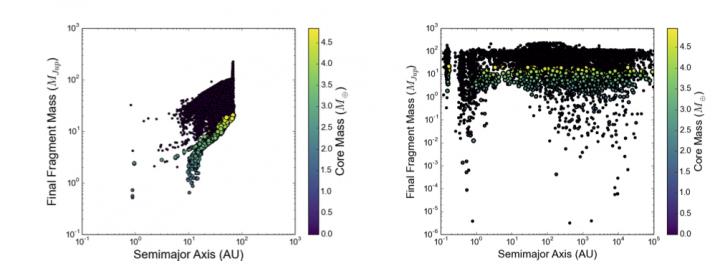Sculpting the population of planets formed via disc fragmentation
Fragment-fragment interactions can play a key role in sculpting the population of planets formed via direct collapse in gravitationally unstable protostellar discs
It is well known that young protostars are surrounded by a circumstellar disc that may, at very early times, be massive enough to develop a gravitational instability. This instability could lead to gravitational collapse in some parts of the discs, results in the direct formation of gaseous, planetary-mass bodies. This fragmentation, however, is only likely to happen in the outer parts of these discs. It is, therefore, possible that this process may explain some of the wide-orbit planets that have been directly imaged. However, it's also been suggested that some of these objects may spiral inwards, lose mass, and ultimately form part of the closer-in exoplanet population.
In an earlier paper, we generated synthetic populations of objects formed via direct gravitational collapse, and showed that these objects predominantly remain massive and on wide-orbit and that, therefore, are unlikely to contribute to the formation of the close-in exoplanet population. In a recent paper, we've updated this earlier work and considered some processes that were not intially considered. In particular, we included the interaction between fragments in the same disc. This can lead to gaseous objects being scattered onto orbits that are prohibited if fragment-fragment scattering is ignored.

The figure on the right shows the results from this work. The left-hand panel is for the case in which fragment-fragment interactions are ignored, while the right-hand panel shows the outcome if they are included. With fragment-fragment interactions included, we still find that the population is dominated by massive objects on wide orbits. However, there is an increase in the number of objects on closer orbits, and a slight increase in the number of objects that may lose enough mass to become close-in, rocky objects (although their survival is unclear). We also find that many objects are ejected, suggesting that this may be an efficient way to generate free-floating planetary mass bodies. A particular prediction of this work is that we expect most of these systems to only have a few objects that survive on bound orbits, suggesting that direct imaging surveys will probably find few systems in which there are multiple wide orbit companions.

